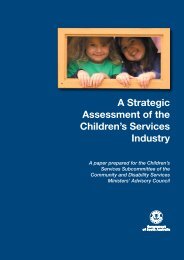Global Study On Child Poverty And Disparities (PDF) - Social Policy ...
Global Study On Child Poverty And Disparities (PDF) - Social Policy ...
Global Study On Child Poverty And Disparities (PDF) - Social Policy ...
Create successful ePaper yourself
Turn your PDF publications into a flip-book with our unique Google optimized e-Paper software.
live in Tafea. <strong>Poverty</strong> is deeper in Torba, but<br />
Tafea appears to have a significant concentration<br />
of poverty, due to its higher share of the total<br />
population.<br />
Port Vila moves from the bottom of the poverty<br />
ranking to the top when the sub-national BNPL<br />
is used. It appears that the poverty experienced<br />
in Port Vila is related to its much higher cost of<br />
living. Apart from location, the most important<br />
factors associated with poverty are large<br />
household size and low educational attainment.<br />
The presence of young adults (15-24 years) also<br />
increases poverty risks.<br />
POVERTY MEASURED BY<br />
DEPRIVATION<br />
Methodology of UNICEF <strong>Global</strong> <strong>Child</strong><br />
<strong>Poverty</strong> <strong>Study</strong><br />
Although income- or expenditure-based poverty<br />
measures focus on an important dimension of<br />
well-being, they only give a partial picture of the<br />
circumstances of disadvantaged families. Income,<br />
for example, is a measure of the resources<br />
available to households, while expenditures can<br />
be thought of as what households achieve with<br />
these resources. But in addition, it is important<br />
to understand the circumstances of households<br />
and the qualitative outcomes they achieve. For<br />
example, two households may have similar<br />
income levels, but one may have access to<br />
electricity and running water while the other<br />
may not. Considering evidence of deprivation<br />
is a way of supplementing information on<br />
household expenditure levels to provide a more<br />
comprehensive account of household well-being,<br />
and therefore of child well-being.<br />
The <strong>Global</strong> <strong>Study</strong> adopts a child poverty concept<br />
that builds on existing definitions and measures of<br />
poverty, and considers:<br />
• both income and non-income factors of the<br />
caretakers or the household, and how these<br />
determine whether or not a child enjoys her or his<br />
right to survive, grow and develop<br />
• how resource scarcity and deprivation directly<br />
affect children, as well as how they are more<br />
broadly experienced differently according to<br />
gender, age and social status at the family,<br />
household or country level<br />
• childhood as a space that is separate from<br />
adulthood (life-cycle approach)<br />
• the likelihood that children who are deprived of a<br />
safe and caring environment will also experience<br />
other deprivations<br />
As the <strong>Global</strong> <strong>Study</strong> points out, the first challenge<br />
in discussing poverty is how to measure it. A<br />
credible measure of poverty can be a powerful<br />
instrument for focusing the attention of policy<br />
makers on the living conditions of the poor. In the<br />
same way, a credible measure of child poverty<br />
can be a powerful instrument for focusing the<br />
attention of policy makers on the rights and wellbeing<br />
of children. So, for any stakeholder working<br />
for children, the way to approach child poverty is<br />
of utmost concern.<br />
The <strong>Global</strong> <strong>Study</strong> also argues that children<br />
experience all forms of poverty more acutely than<br />
adults because of their vulnerability due to age<br />
and dependency, and because lost opportunities<br />
in childhood often cannot be regained later in life.<br />
Considering this, UNICEF’s 2005 State of the<br />
World’s <strong>Child</strong>ren sets out a working definition of<br />
child poverty, which is inspired by the principles of<br />
the Convention on the Rights of the <strong>Child</strong> (CRC),<br />
focuses on the resources children need to survive<br />
and grow: “<strong>Child</strong>ren living in poverty are deprived<br />
of their rights to survival, health and nutrition,<br />
education, participation, and protection from<br />
harm, exploitation and discrimination. (…)<strong>Child</strong>ren<br />
whose rights to safety and dignity are denied are<br />
also impoverished. (…), preventing them from<br />
achieving anything close to their full potential.”<br />
(UNICEF, SOWC 2005, p2).<br />
Here material resources include income, food,<br />
access to education or health services, and<br />
protection from health risks, such as those<br />
associated with hard physical work. Spiritual<br />
resources include stimuli, meaningfulness,<br />
expectations, role models and peer relationships;<br />
emotional resources include love, trust, feelings<br />
of acceptance, inclusion, and absence of abuse.<br />
There are obvious challenges to measuring these,<br />
and few available indicators.<br />
Box 2 summarizes three conceptual models for<br />
understanding child poverty. Model A presents<br />
the way much of the world sees child poverty –<br />
as indistinguishable from overall poverty. This<br />
approach starts with a macro view of poverty that<br />
must be disaggregated (made more specific)<br />
in order to reveal poverty at the community or<br />
household level. This broad model may present<br />
strategic opportunity for advocates of child rights,<br />
since it already includes children (although in an<br />
implicit or invisible manner) in this broad concept<br />
of poverty. Disadvantaged children can benefit<br />
from economic growth through two key channels:<br />
42
















